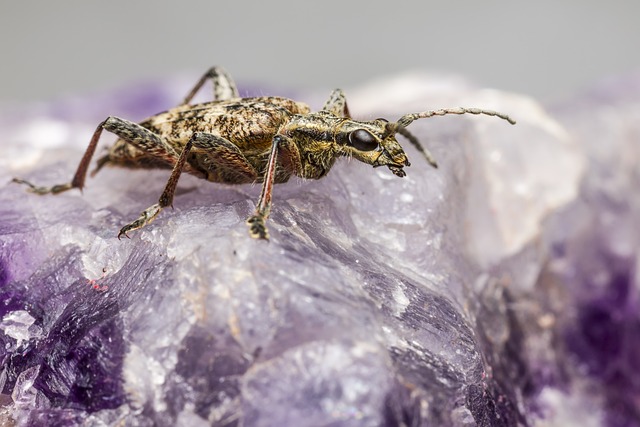Drugstore beetles (Troctina curvisignata and Trogodera reticulata) are household pests attracted to warmth, darkness, moisture, and a variety of foods and materials. Their life cycle includes egg, larva (burrowing), pupa, and adult stages. Effective treatment involves sanitation, eliminating access points, reducing moisture, proper ventilation, and airtight storage. Key steps include regular vacuuming with a HEPA filter, sealing entry points, using natural deterrents like essential oils and herbs, and maintaining cool, dry conditions to disrupt their breeding cycle, minimizing the need for chemical interventions.
Drugstore beetles can quickly infest homes and businesses, causing damage to stored products. This comprehensive guide provides professional advice on reducing attractants and effectively treating drugstore beetle infestations. We’ll explore their behavior, common attractants like heat, moisture, and specific scents, and natural repellents. Learn practical strategies for prevention and safe, effective treatment options tailored for drugstore beetles, ensuring a pest-free environment.
Understanding Drugstore Beetles: Their Behavior and Preferred Environments
Drugstore beetles, scientifically known as Troctina curvisignata, are a common household pest with a preference for stored products and organic materials. Understanding their behavior and preferred environments is crucial when it comes to effective drugstore beetle treatment. These beetles are attracted to warmth, darkness, and moisture, often infesting areas like pantries, attics, and storage rooms. They feed on various items, including spices, cereals, nuts, and even fabrics made from natural fibers.
Their life cycle involves several stages: egg, larva, pupa, and adult. Larvae are the most destructive as they burrow through materials to reach food sources. Adults are good flyers and can quickly spread throughout a structure. To effectively manage drugstore beetles, it’s essential to eliminate their access points, reduce moisture levels, maintain proper ventilation, and store items in airtight containers, especially those made from plastic or glass.
Identifying Common Attractants That Draw Drugstore Beetles
Drugstore beetles, often considered a nuisance, are attracted to a variety of common household items and materials. Identifying these attractants is the first step in implementing an effective drugstore beetle treatment strategy. One of the primary draws for these pests is the presence of carbohydrates, proteins, and fats found in many stored products like grains, nuts, spices, and dried goods. They are also drawn to damp or musty conditions, making areas with poor ventilation or water damage particularly vulnerable.
In addition to food sources and moisture, drugstore beetles are attracted to certain fabrics and natural materials. Items made of wood, paper, cardboard, and fabric can serve as hiding spots and breeding grounds if not properly stored. Understanding these attractants allows homeowners and businesses to take proactive measures, such as maintaining a clean environment, sealing entry points, and using appropriate storage methods, to deter drugstore beetles from infesting spaces.
Effective Strategies for Drugstore Beetle Prevention and Control
Drugstore beetles, or Trogodera reticulata, can be a nuisance in any home, especially for those who store items like textiles, cereals, and spices. Preventing and controlling these pests requires a multi-pronged approach that combines sanitation, storage practices, and environmental adjustments. Regularly cleaning affected areas with a vacuum cleaner equipped with a HEPA filter is crucial to remove larvae and eggs. This should be followed by sealing cracks, crevices, and entry points to prevent future infestations.
For long-term drugstore beetles treatment, altering storage habits can significantly help. Store items in airtight containers made from glass or hard plastic, ensuring they are not exposed to light. Additionally, maintaining a cool, dry environment below 50°F (10°C) is less appealing to drugstore beetles. Monitoring stored goods for any signs of infestation and promptly addressing them can also prevent the need for more aggressive chemical interventions, which should only be considered as a last resort due to potential health and environmental risks.
Natural Repellents and Safe Treatment Options for Drugstore Beetles
When it comes to tackling drugstore beetle infestations, there are several natural repellents and safe treatment options that can be effective in keeping these pests at bay. Essential oils like lavender, peppermint, and eucalyptus are known for their insect-repelling properties and can be used as a natural barrier against drugstore beetles. These aromatic substances disrupt the beetles’ sensory systems, making them less attracted to the treated areas.
In addition to essential oils, certain plants act as natural deterrents. For instance, planting herbs like basil, mint, and lemongrass around vulnerable areas can help repel drugstore beetles. Alternatively, safe treatment methods include using diatomaceous earth, a natural powder that damages the beetles’ exoskeletons, or applying alcohol-based sprays directly to infested surfaces. These solutions are environmentally friendly and effective in disrupting beetle activity without resorting to harmful chemicals.
Drugstore beetles can be a persistent problem, but with a multi-faceted approach, their presence can be significantly reduced. By understanding these insects’ behavior and identifying their preferred attractants, individuals can implement effective prevention strategies. Combining natural repellents and safe treatment options offers a holistic drugstore beetle treatment approach, ensuring homes remain pest-free while maintaining a healthy environment. Remember, proactive measures are key to keeping these intruders at bay.
